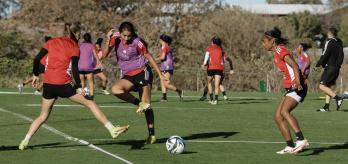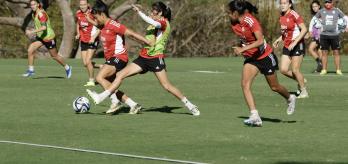Quick combinations such as playing the ball into the number 9 for them to spread play out wide can be an effective way to cut through a defence that sits high up the pitch. Finding players between the opposition’s defensive lines and in wide areas can allow teams to launch quick attacks and create overloads.
In this session, the head coach of the Costa Rican women’s national team, Beni Rubido, and one of his assistant coaches, Patricia Aguilar, deliver three exercises aimed at providing players with the principles to attack at pace. The first exercise involves an attacking technical circuit featuring a passing sequence that culminates in players darting into the penalty area to finish on goal. The second drill introduces two attacking overloads, and the session is rounded off with a 11v11 game in which both teams are tasked with playing with a high defensive line.
Session overview
Key coaching points
-
The timing of runs and passes is key to breaking the opposition’s defensive lines, and players should identify the space that they intend to move into before the passer sets themselves to play the pass.
-
Players should make various runs and perform different actions based on the overload scenario. In a 8v6 overload, players should focus on using width, while in a 4v3 scenario, the emphasis should be maintaining a narrow shape and players making more interchanging runs.
-
When players are in wide areas with space, they should attack aggressively and deliver crosses from the most effective position based on their team-mates’ supporting runs.
Part 1: Attacking technical circuit
The first exercise is designed to activate the players through a position-specific technical circuit. The first part of the sequence involves a centre-forward (A), who is passively pressed by a centre-back, dropping to receive a pass before playing the ball out wide to set up a crossing scenario and a shot on goal.
-
Use 1 half of a full-size pitch and 1 full-size goal and goalkeeper at one end.
-
Set up the cones and poles as seen in the image above.
-
Split the players into 2 equal groups (2 defenders and 7 attackers) and position them as seen in the image above.
-
D passes to A.
-
A and B must move through the poles and toward the ball.
-
A must receive the ball on the half-turn and use B’s passive press to decide which way they will turn.
-
A must pass to C and sprint into the penalty area beyond the poles.
-
C must dribble down the line and attack the space around the second dummy and cross to A.
-
A and C' from the opposite channel attack the cross.
-
Meanwhile, B receives a pass from D and must try to beat D in a 1v1 to score in the mini goals.
-
Once B completes the pass, B must sprint into the penalty area, where a coach will feed them with a cross to attempt to score.
-
Players must move to stations in a clockwise manner.
-
The offside rule applies.
-
The attacker dropping to receive the ball can now lay the ball off instead of turning to play forward.
-
B must press from multiple sides to try and control A’s movement and create a sense of realism.
-
Timing is crucial for executing the circuit with high levels of intensity and realism.
-
Wide players must use the dummy to time movements to receive and can make feints or double movements before receiving and then attempt to orientate their control forward.
-
Attack the dummies with aggression as if it was a full-back and the objective was to pin them.
-
A must spin away immediately after playing out wide and pay attention to where the wide player is crossing from and the type of cross they will use.
Part 2: 9v9 plus 2- creating overloads
The second exercise applies the attacking and defensive principles worked on in the first drill in a match scenario that features two attacking overload scenarios. The exercise involves different numerical advantages and disadvantages, giving rise to a variety of attacking and defensive situations.
-
Use a full-size pitch and mark out a 30x60m area in the centre with a full-size goal and goalkeeper at each end.
-
Split the group into 2 teams; there are 2 extra players on each team.
-
Position both teams inside and around the central area with the orange team in a 4-2-3 structure and the blue team in a 3-4-2 structure.
-
The 2 extra players on the orange team should be positioned in between the blue team’s defensive lines and the 2 extra players on the blue team must wait out wide and in the opposition’s half.
-
The orange team start with the ball and must try to link with the extra players waiting in between the lines to initiate a 4v3 overload attack in the last third of the pitch.
-
If the blue team wins the ball, they must get it to the wide extra players and initiate an 8v6 attacking overload in the opposite third of the pitch.
-
Other players cannot join in the attacking scenarios.
-
If the ball goes out of play, the coach will play a quick pass into one of the two wide players.
-
Switch the teams around so they get to play in both systems.
-
When building an attack, teams should alternate inside and outside passing combinations forcing the midfielders to work on their positioning and balance.
-
Players can play quick long passes should the opportunity present itself or if other routes are blocked.
-
Encourage players to finish an attack in under 4 seconds so that they take advantage of numerical superiority.
-
Goalkeepers must stay high up on the pitch to condense the pitch as much as possible.
-
Wide players should be ready to burst forward at any moment to exploit gaps in between defenders around the back.
-
Players in between the lines should read the play to offer intelligent passing lanes.
Part 3: 11v11 game
The final exercise is a standard 11v11 match in which both teams set up in a 4-4-2 formation. Players are tasked with implementing the attacking principles worked on throughout the session in a real-game scenario.
-
Use a full-size pitch with a full-size goal and goalkeeper at each end.
-
Split the group into 2 teams of 10 and position them in a 4-4-2 formation.
-
Play starts from the centre circle and the team in possession must build-up play and try to score.
-
The opposition must try to win the ball and score.
-
Once the ball enters the final third, both teams should attack and defend in numbers.
-
If the ball goes out of play, a coach plays a second ball to encourage transitions.
-
The defensive line should push up to the halfway line when the opposition are deep in their own half.
-
If possession is won in the opposition’s half, or when the opposition has overcommitted, the attacking team must break in numbers and quick actions.
-
Number 9s should drop and help connect play whilst pulling centre-backs out of position.
-
Wide players must keep the width and try to stretch the space and be prepared for runs in behind.















